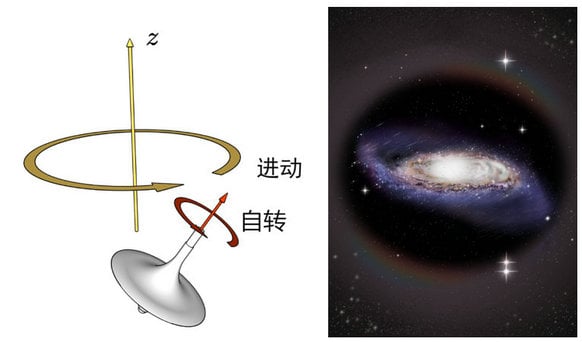Astronomers have unveiled the shape of our galaxy’s dark matter halo by observing the Milky Way’s warped disk. A team led by Dr. HUANG Yang from the National Astronomical Observatories of the Chinese Academy of Sciences (NAOC) used a novel “motion picture” method to measure the precession of our galaxy’s disk warp. Their findings, published in Nature Astronomy, suggest that the Milky Way’s dark matter halo is slightly flattened.
Many disk galaxies, including our own Milky Way, aren’t perfectly flat. Instead, they have a warped shape that astronomers compare to a potato chip. This warp is thought to occur when the outer disk stars’ rotation plane differs from the symmetry plane of the surrounding dark matter halo. Like a tilted spinning top, this misalignment causes the galactic disk to precess due to the dark matter halo’s gravitational pull.
A New View of the Milky Way’s Warp
Previous attempts to measure the direction and rate of this precession have been controversial. These earlier studies relied on indirect methods using tracers affected by various dynamic disturbances, limiting their accuracy.
To overcome these challenges, the research team used 2,600 young classical Cepheid variable stars discovered by the Gaia space telescope. These stars, along with precise distance and age data from Gaia and LAMOST, allowed the researchers to construct a three-dimensional picture of the Milky Way’s disk across different age groups, all younger than 250 million years.
By observing how the disk warp changes with stellar age, the team discovered that the warp precesses in a retrograde direction at a rate of 2 km/s/kpc, or 0.12 degrees per million years.
Unveiling the Dark Matter Halo
The researchers found that the warp’s precession rate gradually decreases with distance from the galactic center. After accounting for the inner disk’s influence, they determined that the dark matter halo surrounding the warp has a slightly oblate ellipsoidal shape.
Specifically, the equipotential surfaces of the dark matter halo have a flattening ratio between 0.84 and 0.96. This shape is the only one that can explain the observed precession rate of the warp after subtracting the inner disk’s contribution.
This study provides a crucial reference point for understanding how the Milky Way’s dark matter halo has evolved over time. By using the galaxy’s own structure as a probe, astronomers have gained new insights into the mysterious dark matter that makes up a significant portion of our galaxy’s mass.
The innovative “motion picture” approach used in this research opens up new possibilities for studying galactic structure and evolution. As we continue to gather more precise data on our galaxy’s stars, we may uncover even more secrets about the invisible dark matter that shapes the cosmos.
If our reporting has informed or inspired you, please consider making a donation. Every contribution, no matter the size, empowers us to continue delivering accurate, engaging, and trustworthy science and medical news. Independent journalism requires time, effort, and resources—your support ensures we can keep uncovering the stories that matter most to you.
Join us in making knowledge accessible and impactful. Thank you for standing with us!

